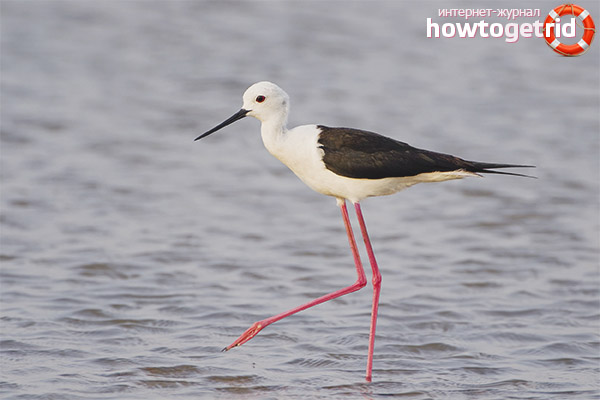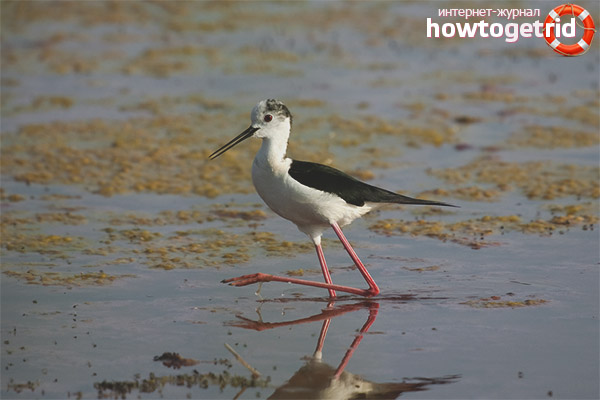The content of the article
A distinctive feature of stilt birds are long pink legs. It is for them that this species can be easily distinguished from any other bird. Stilt - a relative of shiloklyuvki.
Appearance
The body length is about 40 cm. Almost the entire body of the bird is covered with white plumage. The wings are long. There is a black spot on the head that looks like a hat. In males, this “hat” has a darker shade than in females. The wingspan is about 75 cm. In addition, the females are smaller.
Outwardly, the bird resembles the representatives of the ankle order, in particular, the black and white stork. But the size of the stilt is several times smaller. If you translate the name of this bird from Spanish, it will sound like a "little stork." The size is the same as a gray dove. The legs of the bird are twice as long as its body. The long black beak reaches about 5 cm. The body weight can be about 175-200 g. The female has a more dull color.
Habitat
As already mentioned, the presence of long legs is the main difference between the stilt. This leg length helps the bird hiccup its food, as it spends most of its time in shallow water, where it looks out for prey.
This species inhabits the Don, in Primorye, Transbaikalia. They are also on the African continent, Australia, some Asian countries, as well as on the island of Madagascar and in New Zealand. A stilt lives on rivers and lakes. Long legs allow the bird to move further from the coast.
Lifestyle
They live in colonies of about 20 to 100 birds each. They choose a quiet place, away from the coast with tides. They can also settle in artificial ponds. Seeing a person even from afar, they try to hide from sight as quickly as possible. Mostly they move in slow steps, but sometimes they can run. Feet allow you to walk comfortably in shallow water. But when walking on the ground the bird has difficulties.
During the flight very often flaps its wings. The legs in this case act as a helm.
Individuals that live in temperate climates are migratory. They return to their usual nesting sites around April. Since they constantly walk along the coast, individuals leave characteristic traces by which one can understand the presence of a bird in this area. They leave large footprints. Paws have three fingers about 6 cm in length. The method of transportation is unusual. The stilt walker makes a step large for its size - about 25 cm. The bird does not rest on the whole foot, but walks only on the fingers, from which traces remain.
The voice is loud. It produces sounds that can be described as “kick-kick-kick”.
They have a daily lifestyle. Almost all the time they spend on the shore or in the vicinity of the reservoir. Stilt walkers not only walk along the shore, but also swim and dive perfectly.
Nutrition
Stilt people have a rather peculiar way of eating. They are immersed in water with almost the whole body, only the tail remains on the surface.
With its beak, the bird is looking for food. They catch water bugs, bloodworms. In addition, they can feed on tadpoles, bugs, vegetation. These birds could well find food on the surface of the earth, but their whole body is adapted specifically for hunting in shallow water. In addition, the presence of long legs makes hunting on land uncomfortable.
Long legs also allow the bird to get prey from a depth that is not accessible to other birds. A bird's beak is very similar to tweezers.It is as if created specifically to catch insects in the water.
Breeding

The bird selects a nesting site so that nearby it is possible to get enough food for themselves and offspring. The colony is 100 or more pairs. For several seasons, the pair persists, after which the bird can find a new partner.
Interestingly, it is females who show courtship. They choose a male, paying attention to them. They hatch eggs together. When the female sits on the eggs, the male carefully brings food for her. And when the chicks are born, the male brings food to them.
These birds are quite sociable, therefore they rarely remain alone. During nesting, they form colonies of 20-30 pairs.
Alone, couples practically do not nest. Such a phenomenon can be met extremely rarely. Sometimes they adjoin colonies of birds of other species, nesting nearby.
The nest is a hole that birds line with branches, stalks and grass. If the first masonry was damaged, then the pair will postpone another. But, despite this, this species has a rather low breeding success. It is 15-45%.
Pairs form in April-May. In a clutch there are usually about 4 eggs 3-4 cm in size. In the second half of May, a female stilt lays eggs. The incubation period can last about a month. Parents protect their defenseless chicks from the threat. The first few weeks, they actively feed offspring so that the chicks grow and grow with feathers.
At about the age of one month, they begin to get used to living independently and try to fly. Chicks learn to get food for themselves. At a young age, the plumage has a brown color, which eventually changes to white.
Chicks are developing rapidly. The plumage in them is somewhat lighter than in adults. They reach puberty at the age of two. Total stilt live for about 12 years.
These birds take good care of the offspring, protecting them from the threat. Sometimes they can endanger themselves to protect their chicks. If a predator or other threat approaches, the bird takes off and screams, trying in this way to distract the enemy.
For various reasons, a lot of stilt clutches die, which also affects the population size. Sometimes they become victims of hunters, but more often by chance. After all, few people want to shoot such an interesting bird. Moreover, she has very little meat.
Important! Today this species is protected by law, hunting for them is prohibited.
Man brings indirect damage to this species by using coastal territory for its activities, and making it unsuitable for birds to live. In tropical latitudes, this species is safe. In Spain and Italy, their number is increasing.
Interesting Facts
- Sometimes for a stilt they take a shiloklyuvka, which is an inhabitant of southern Europe. Outwardly, they are similar, but has a curved beak. Her legs are somewhat shorter, have a bluish tint. Her wings are black and white.
- Those individuals that live in countries with very hot climates should cool their eggs. Therefore, before sitting on the nest, the bird moistens its plumage.
- When the stilt hatches eggs, his legs are bent and are behind.
- Despite the large length of the legs compared with the body, this bird occupies only the second place in this indicator. In the first place there is a flamingo.
Video: stilt (Himantopus himantopus)











Submit